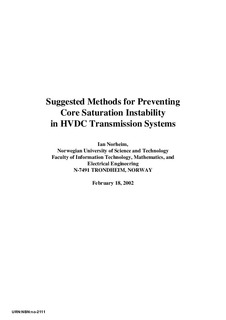| dc.contributor.author | Norheim, Ian | nb_NO |
| dc.date.accessioned | 2014-12-19T13:29:32Z | |
| dc.date.available | 2014-12-19T13:29:32Z | |
| dc.date.created | 2002-03-19 | nb_NO |
| dc.date.issued | 2002 | nb_NO |
| dc.identifier | 123987 | nb_NO |
| dc.identifier.isbn | 82-471-5407-2 | nb_NO |
| dc.identifier.uri | http://hdl.handle.net/11250/249741 | |
| dc.description.abstract | In this thesis a study of the HVDC related phenomenon core saturation instability and methods to prevent this phenomenon is performed. It is reason to believe that this phenomenon caused disconnection of the Skagerrak HVDC link 10 August 1993. Internationally, core saturation instability has been reported at several HVDC schemes and thorough complex studies of the phenomenon has been performed. This thesis gives a detailed description of the phenomenon and suggest some interesting methods to prevent the development of it.
Core saturation instability and its consequences can be described in a simplified way as follows:
It is now assumed that a fundamental harmonic component is present in the DC side current. Due to the coupling between the AC side and the DC side of the HVDC converter, a subsequent second harmonic positive-sequence current and DC currents will be generated on the AC side. The DC currents will cause saturation in the converter transformers. This will cause the magnetizing current to also have a second harmonic positive-sequence component. If a high second harmonic impedance is seen from the commutation bus, a high positive-sequence second harmonic component will be present in the commutation voltages. This will result in a relatively high fundamental frequency component in the DC side voltage. If the fundamental frequency impedance at the DC side is relatively low the fundamental component in the DC side current may become larger than it originally was. In addition the HVDC control system may contribute to the fundamental frequency component in the DC side voltage, and in this way cause a system even more sensitive to core saturation instability. The large magnetizing currents that eventually will flow on the AC side cause large zero-sequence currents in the neutral conductors of the AC transmission lines connected to the HVDC link. This may result in disconnection of the lines. Alternatively, the harmonics in the large magnetizing currents may cause overheating of filters or other components. This may also cause disconnection.
In this thesis, several ways to reduce/eliminate the core saturation instability problem are described and most of them are also demonstrated by simulations on a modified CIGRE HVDC benchmark model in PSCAD/EMTDC version 3. PSCAD/EMTDC version 3 is a powerful simulation tool which perform simulations in the time domain and offers detailed models for transformers, power electronic switches etc. To understand and have confidence in the simulation results, the transformer models, the model for the on-line frequency scanner, and models for power electronic switches are evaluated in detail.
The suggested initiatives that were successfully simulated are listed below:
1) Stabilizing loops in the control system of the HVDC link.
These loops diminish the influence of the HVDC control system on core saturation instability. Some of the loops suggested are believed to give improvements in applications where it is required that the stabilizing loop are only active for a small band of frequencies.
2) A hybrid shunt filter connected to the commutation bus on the AC side.
The hybrid filter consists of a PWM converter in addition to a passive circuit of components. It is superior to the plain passive filter because it does not cause any resonances with the AC grid and because it is not as sensitive to component drifting as passive filters. The hybrid filter prevents most of the second harmonic current generated by the HVDC converter to flow into the AC grid. This way the second harmonic component in the commutation voltages is significantly decreased.
3) A passive shunt filter connected to the commutation bus on the AC side.
Functions the same way as the hybrid shunt filter, but it may create resonances with the AC net. In addition it is more sensitive for changes in the component values than the hybrid filter.
4) A blocking LC filter between the low voltage potential and earth on the DC side
This filter blocks any fundamental frequency current from flowing on the DC side at the same time as it allows the DC component in the DC side current to flow through it. By placing the filter between the low voltage potential and earth on the DC side it does not have to sustain the DC side voltage.
It is 1) that represent the most preferable solution. It does not introduce any new components in the AC or DC grid, and it is inexpensive compared to the other solutions. The solutions in 2), 3), and 4) requires large and expensive components. However, it might be that in future schemes hybrid filters replaces passive filters on the AC side. Then it might be inexpensive and convenient to use the hybrid filters to prevent core saturation instability. | nb_NO |
| dc.language | eng | nb_NO |
| dc.publisher | Fakultet for informasjonsteknologi, matematikk og elektroteknikk | nb_NO |
| dc.relation.ispartofseries | Dr. ingeniøravhandling, 0809-103X; 2002:15 | nb_NO |
| dc.title | Suggested Methods for Preventing Core Saturation Instability in HVDC Transmission Systems | nb_NO |
| dc.type | Doctoral thesis | nb_NO |
| dc.source.pagenumber | 199 | nb_NO |
| dc.contributor.department | Norges teknisk-naturvitenskapelige universitet, Fakultet for informasjonsteknologi, matematikk og elektroteknikk | nb_NO |
| dc.description.degree | dr.ing. | nb_NO |
| dc.description.degree | dr.ing. | en_GB |
